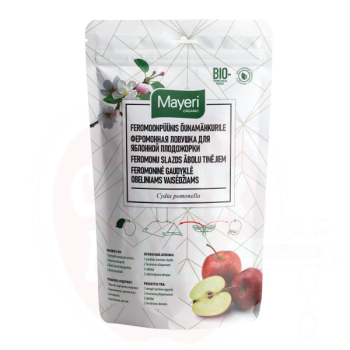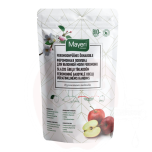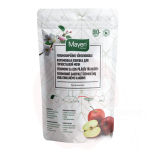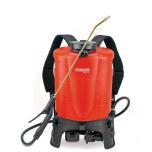Pheromone trap apple damager
![]() Professionals recommend - producers prefer!
Professionals recommend - producers prefer!
EAN: 4740060005350
Brand: Mayer
Unit: tk
Stock qty: 42
Leveranstid inom Estland för lagervaror ca 3-5 arbetsdagar. OBS! På grund av den snabba prisökningen kan priser för icke-lagervaror ändras utan föregående meddelande! Standardpriser med 22% moms.
179,00 €/Kg
Codling Moth Pheromone Trap - Effective Solution for Apple Orchard Protection
The set includes a cardboard trap, 2 pheromone capsules, 2 glued sticky bases, and fastening parts. It is recommended to use one trap per apple tree.
Description and Life Cycle of Codling Moth
The Codling Moth (Cydia pomonella) is a 10 mm long brownish-gray butterfly with a wingspan of 20 mm. Moths are active at dusk in warm and calm weather. Female moths lay eggs on fruits and leaves, caterpillars hatch within 7-14 days and feed inside fruits for 1-1.5 months.
Trap Installation and Usage
To assemble the trap:
- Bend up the ends of the trap base
- Place the sticky base with adhesive facing up
- Position the pheromone capsule in the center of the sticky base
- Attach the trap to a branch using included parts
Install the trap on the south or west side of the apple tree, protected from direct sunlight. For monitoring, place the trap at eye level, for catching at 2-3 meters height.
Trap Maintenance and Monitoring
Check traps weekly. If there are more than 5 moths per week in the trap, spraying is recommended within 7-14 days. Replace the sticky base every 3-4 weeks or when heavily soiled. In mid-July, replace both the sticky base and pheromone capsule.
Long-term Protection
Noticeable reduction in codling moth damage is achieved within 2-3 years. Continue using traps for sustained protection. Pheromone traps are particularly suitable for home gardens where reduced insecticide use is desired.
Note: Use white spirit or cooking oil to clean sticky bases. The trap body can be reused for the same insect species next season.
Keywords: codling moth, pheromone trap, apple orchard, pest control, insect catching, pest control tools, sticky trap, garden protection
| Weight (kg) | 0.050000 |
| High (m) | 0.03 |
| Width (m) | 0.17 |
| Length (m) | 0.27 |
Pea moth pheromone trap is an ecological solution to protect peas from pests. In small gardens, 2-3 traps per pea bed are sufficient. In larger fields, place traps 20 meters apart around the perimeter and several in the center.
Trap Features and Usage
The pheromone trap consists of a plastic housing, sticky base, and pheromone capsules. The device attracts pea moth butterflies that get stuck on the sticky base. With the trap you can detect pest presence in the garden, assess pea moth population, and reduce pest population.
Installation and Maintenance
To install the trap: Bend up the ends of the trap's bottom surface. Place the sticky base with adhesive side up. Place the pheromone capsule in the center of the sticky base. Attach the trap to a branch using included parts.
Package Contents
Package includes: 1 plastic trap, 2 pheromone capsules, 2 adhesive sticky bases, 2 attachment parts.
Pea Moth Description and Life Cycle
Pea moth butterflies have a 12-16 mm wingspan, are gray or brown with yellow side markings. Caterpillars are 6 mm long, white or yellow with dark heads. Pests are active from July to August when they feed on pea pods.
Note! To remove adhesive from hands, use white spirit or cooking oil. Store spare capsules in a cool place in sealed packaging.
Pea moth pheromone trap is an ecological solution to protect peas from pests. In small gardens, 2-3 traps per pea bed are sufficient. In larger fields, place traps 20 meters apart around the perimeter and several in the center.
Trap Features and Usage
The pheromone trap consists of a plastic housing, sticky base, and pheromone capsules. The device attracts pea moth butterflies that get stuck on the sticky base. With the trap you can detect pest presence in the garden, assess pea moth population, and reduce pest population.
Installation and Maintenance
To install the trap: Bend up the ends of the trap's bottom surface. Place the sticky base with adhesive side up. Place the pheromone capsule in the center of the sticky base. Attach the trap to a branch using included parts.
Package Contents
Package includes: 1 plastic trap, 2 pheromone capsules, 2 adhesive sticky bases, 2 attachment parts.
Pea Moth Description and Life Cycle
Pea moth butterflies have a 12-16 mm wingspan, are gray or brown with yellow side markings. Caterpillars are 6 mm long, white or yellow with dark heads. Pests are active from July to August when they feed on pea pods.
Note! To remove adhesive from hands, use white spirit or cooking oil. Store spare capsules in a cool place in sealed packaging.
.png)







